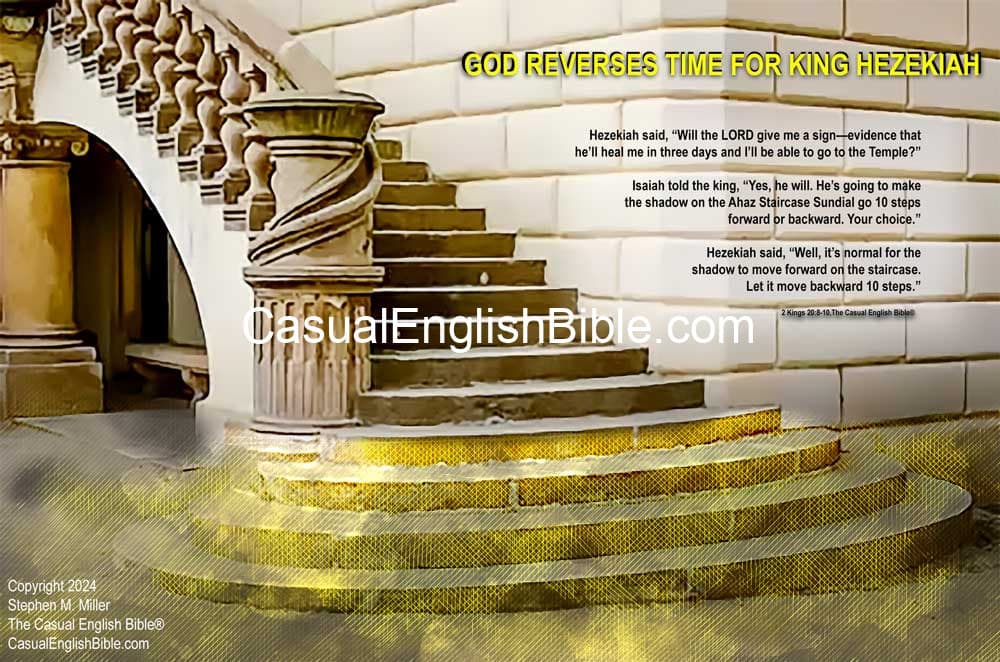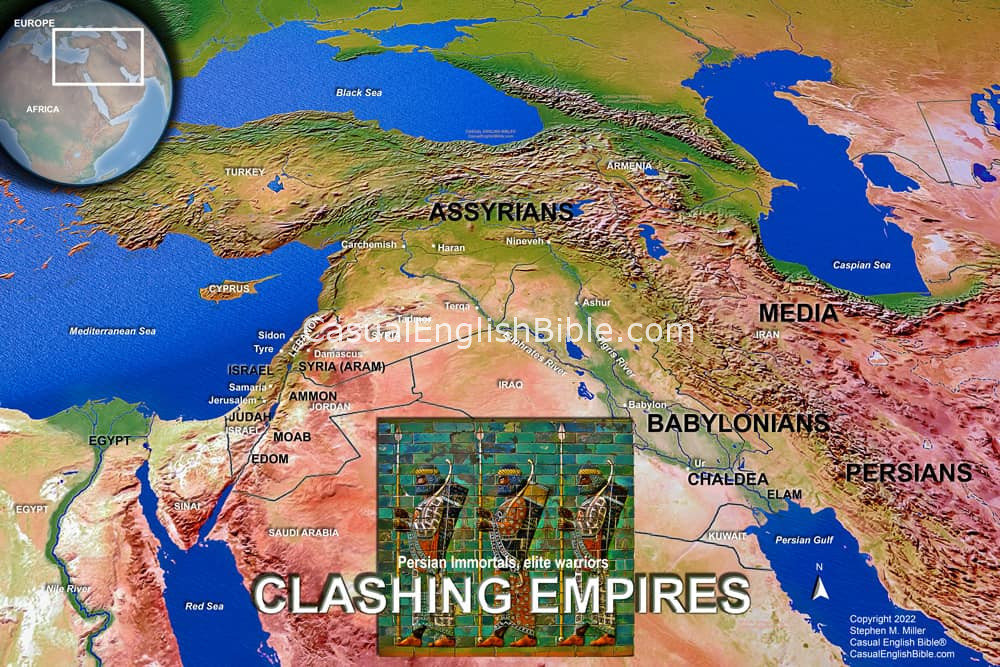2 Kings 20
“Hezekiah, you’re a goner”
Hezekiah on his deathbed
2 Chronicles 32:24-26; Isaiah 38:1-8, 21,22 1Hezekiah got terribly sick at the time. He was about to die. Isaiah son of Amoz came to him and delivered the bad news. “This message is from the LORD. You’re going to die. Get your personal and business affairs in order. You’re not going to get well.” 2Hezekiah turned away from Isaiah and faced the wall. He started praying to the LORD. 3“Please LORD, I have lived my life devoted to you with all my heart. I’ve behaved myself and done what you wanted.” Hezekiah sobbed in grief. On second thought: 15 more years
4Isaiah hadn’t gotten any further than the middle of the palace courtyard before the LORD spoke to him. 5“Turn around,” the LORD said. “Go back to Hezekiah. Tell him the LORD, the God of your ancestor David has another message for him: I see you. I see the tears. I heard your words. I’m going to heal you. In three days you’ll be able to get up out of your bed and go to the Temple. 6And I’m adding 15 years to your life. I’m going to rescue the city, in honor of David. I’m not going to let the Assyrians have it.” 7Isaiah said, “Someone go and get a handful of figs. Then crush them into a paste and apply it to the king’s boil. [1] He’ll get well then.” God turns back the clock
8Hezekiah said, “Will the LORD give me a sign—evidence that he’ll heal me in three days and I’ll be able to go to the Temple?” 9Isaiah told the king, “Yes, he will. He’s going to make the shadow on the Ahaz Staircase Sundial [2] go 10 steps forward or backward. Your choice.” 10Hezekiah said, “Well, it’s normal for the shadow to move forward on the staircase. Let it move backward 10 steps.” 11Isaiah talked to God in a prayer, and the LORD made the shadow on the Ahaz Staircase retreat 10 steps. Hezekiah gives Babylonians the royal tour
Isaiah 39:1-8 12Babylon’s King Merodach-baladan, [3] son of Baladan, heard Hezekiah was sick. So, he sent ambassadors to deliver letters and a gift.
13Hezekiah welcomed the officials. He gave them a royal tour of the treasury: silver, gold, spices, and rare perfumes. Then he showed off his armory—the whole shebang. If there was anything to see in Hezekiah’s palace or in the royal storage buildings, they saw it.
14The prophet Isaiah went to Hezekiah and asked, “Where did these men come from and what did they say to you?” Hezekiah said, “They came a long way, from Babylon.”
15Isaiah said, “What did they see in your palace?” Hezekiah answered, “Everything. I gave them the full tour. I showed them everything in my home and in my warehouses.”
16Isaiah said, “Well then, here’s what the LORD of people everywhere has to say about that: 17There’s a day coming when Babylonians will take everything in your house and everything your ancestors have collected and treasured throughout the years. They won’t leave anything valuable. 18They will even take some of your own sons and turn them into eunuchs [4] who will serve in Babylon’s palace.”
19Hezekiah replied, “Those are good words from the LORD.” But he was thinking, “At least we can count on peace and safety while I’m king.” Hezekiah dead and buried
2 Chronicles 32:32-33 20Hezekiah built the upper pool in Jerusalem and the tunnel to a spring [5] that fed the pool. The rest of his story and all he accomplished are recorded in the History of Judah’s Kings. 21The people buried Hezekiah among his ancestors. His son Manasseh became the next king. Footnotes
120:7This fig remedy is missing from the oldest copy of Isaiah, a 2,000-year-old complete scroll found among the Dead Sea Scrolls, copied around the time of Jesus’s ministry or the century before.
220:9The Ahaz staircase was apparently just a stairway that caught the changing shadows of the day in a way that allowed people to measure time. The builder may have designed the stairway as a sundial or not. But it seems people used it that way. As the sun moved from east to west, the shadow moved from west to east. But for Hezekiah that day, the shadow took a different route. How? Would a passing cloud mimic a shadow? The writer doesn’t say how God did it. And there’s no indication Hezekiah asked.
320:12Merodach-baladan II ruled from 721-710 BC and for nine months in 703. Earlier, Assyria claimed the land of Babylonia, in what is now southern Iraq. But during Assyria’s transition to a new king, Sargon II, in 722, Merodach-baladan declared himself king of Babylon and revolted against Assyria. Assyrians took back the area in 710 BC and then again in 703 BC. He died in 694 BC.
420:18Eunuchs were men who were often castrated and appointed to guard women of kings and of other families rich enough to own slaves. They could perform the manly duties of an employee, without endangering the family tree by grafting in an alien twig or two.
520:20Gihon Spring was Jerusalem’s source of water. Before Hezekiah came along, the spring was cut off from the city—outside the city walls. It was hidden in a small cave at the base of the ridge on which Jerusalem was built. Jerusalem couldn’t survive a long siege without water. And the Assyrians in what is now northern Iraq weren’t looking especially friendly. So, Hezekiah ordered a tunnel chiseled through solid rock, connecting the spring to the pool inside the city. Miners worked on it in two teams at opposite ends and met in the middle. The tunnel stretched 583 yards (530 meters). In time, the tunnel got lost in history, hidden in the cave. It was rediscovered in 1880. Inside was an ancient stone plaque about the quarrymen cutting through the stone with axes.
Discussion Questions
- Sorry, there are currently no questions for this chapter.
Videos
On second thought: 15 more years
4Isaiah hadn’t gotten any further than the middle of the palace courtyard before the LORD spoke to him. 5“Turn around,” the LORD said. “Go back to Hezekiah. Tell him the LORD, the God of your ancestor David has another message for him: I see you. I see the tears. I heard your words. I’m going to heal you. In three days you’ll be able to get up out of your bed and go to the Temple. 6And I’m adding 15 years to your life. I’m going to rescue the city, in honor of David. I’m not going to let the Assyrians have it.” 7Isaiah said, “Someone go and get a handful of figs. Then crush them into a paste and apply it to the king’s boil. [1] He’ll get well then.”God turns back the clock
8Hezekiah said, “Will the LORD give me a sign—evidence that he’ll heal me in three days and I’ll be able to go to the Temple?” 9Isaiah told the king, “Yes, he will. He’s going to make the shadow on the Ahaz Staircase Sundial [2] go 10 steps forward or backward. Your choice.” 10Hezekiah said, “Well, it’s normal for the shadow to move forward on the staircase. Let it move backward 10 steps.” 11Isaiah talked to God in a prayer, and the LORD made the shadow on the Ahaz Staircase retreat 10 steps.Hezekiah gives Babylonians the royal tour
Isaiah 39:1-8 12Babylon’s King Merodach-baladan, [3] son of Baladan, heard Hezekiah was sick. So, he sent ambassadors to deliver letters and a gift.
13Hezekiah welcomed the officials. He gave them a royal tour of the treasury: silver, gold, spices, and rare perfumes. Then he showed off his armory—the whole shebang. If there was anything to see in Hezekiah’s palace or in the royal storage buildings, they saw it.
14The prophet Isaiah went to Hezekiah and asked, “Where did these men come from and what did they say to you?” Hezekiah said, “They came a long way, from Babylon.”
15Isaiah said, “What did they see in your palace?” Hezekiah answered, “Everything. I gave them the full tour. I showed them everything in my home and in my warehouses.”
16Isaiah said, “Well then, here’s what the LORD of people everywhere has to say about that: 17There’s a day coming when Babylonians will take everything in your house and everything your ancestors have collected and treasured throughout the years. They won’t leave anything valuable. 18They will even take some of your own sons and turn them into eunuchs [4] who will serve in Babylon’s palace.”
19Hezekiah replied, “Those are good words from the LORD.” But he was thinking, “At least we can count on peace and safety while I’m king.” Hezekiah dead and buried
2 Chronicles 32:32-33 20Hezekiah built the upper pool in Jerusalem and the tunnel to a spring [5] that fed the pool. The rest of his story and all he accomplished are recorded in the History of Judah’s Kings. 21The people buried Hezekiah among his ancestors. His son Manasseh became the next king. Footnotes
120:7This fig remedy is missing from the oldest copy of Isaiah, a 2,000-year-old complete scroll found among the Dead Sea Scrolls, copied around the time of Jesus’s ministry or the century before.
220:9The Ahaz staircase was apparently just a stairway that caught the changing shadows of the day in a way that allowed people to measure time. The builder may have designed the stairway as a sundial or not. But it seems people used it that way. As the sun moved from east to west, the shadow moved from west to east. But for Hezekiah that day, the shadow took a different route. How? Would a passing cloud mimic a shadow? The writer doesn’t say how God did it. And there’s no indication Hezekiah asked.
320:12Merodach-baladan II ruled from 721-710 BC and for nine months in 703. Earlier, Assyria claimed the land of Babylonia, in what is now southern Iraq. But during Assyria’s transition to a new king, Sargon II, in 722, Merodach-baladan declared himself king of Babylon and revolted against Assyria. Assyrians took back the area in 710 BC and then again in 703 BC. He died in 694 BC.
420:18Eunuchs were men who were often castrated and appointed to guard women of kings and of other families rich enough to own slaves. They could perform the manly duties of an employee, without endangering the family tree by grafting in an alien twig or two.
520:20Gihon Spring was Jerusalem’s source of water. Before Hezekiah came along, the spring was cut off from the city—outside the city walls. It was hidden in a small cave at the base of the ridge on which Jerusalem was built. Jerusalem couldn’t survive a long siege without water. And the Assyrians in what is now northern Iraq weren’t looking especially friendly. So, Hezekiah ordered a tunnel chiseled through solid rock, connecting the spring to the pool inside the city. Miners worked on it in two teams at opposite ends and met in the middle. The tunnel stretched 583 yards (530 meters). In time, the tunnel got lost in history, hidden in the cave. It was rediscovered in 1880. Inside was an ancient stone plaque about the quarrymen cutting through the stone with axes.
Discussion Questions
- Sorry, there are currently no questions for this chapter.
Videos
13Hezekiah welcomed the officials. He gave them a royal tour of the treasury: silver, gold, spices, and rare perfumes. Then he showed off his armory—the whole shebang. If there was anything to see in Hezekiah’s palace or in the royal storage buildings, they saw it.
14The prophet Isaiah went to Hezekiah and asked, “Where did these men come from and what did they say to you?” Hezekiah said, “They came a long way, from Babylon.”
15Isaiah said, “What did they see in your palace?” Hezekiah answered, “Everything. I gave them the full tour. I showed them everything in my home and in my warehouses.”
16Isaiah said, “Well then, here’s what the LORD of people everywhere has to say about that: 17There’s a day coming when Babylonians will take everything in your house and everything your ancestors have collected and treasured throughout the years. They won’t leave anything valuable. 18They will even take some of your own sons and turn them into eunuchs [4] who will serve in Babylon’s palace.”
19Hezekiah replied, “Those are good words from the LORD.” But he was thinking, “At least we can count on peace and safety while I’m king.”
Hezekiah dead and buried
2 Chronicles 32:32-33 20Hezekiah built the upper pool in Jerusalem and the tunnel to a spring [5] that fed the pool. The rest of his story and all he accomplished are recorded in the History of Judah’s Kings. 21The people buried Hezekiah among his ancestors. His son Manasseh became the next king. Footnotes
120:7This fig remedy is missing from the oldest copy of Isaiah, a 2,000-year-old complete scroll found among the Dead Sea Scrolls, copied around the time of Jesus’s ministry or the century before.
220:9The Ahaz staircase was apparently just a stairway that caught the changing shadows of the day in a way that allowed people to measure time. The builder may have designed the stairway as a sundial or not. But it seems people used it that way. As the sun moved from east to west, the shadow moved from west to east. But for Hezekiah that day, the shadow took a different route. How? Would a passing cloud mimic a shadow? The writer doesn’t say how God did it. And there’s no indication Hezekiah asked.
320:12Merodach-baladan II ruled from 721-710 BC and for nine months in 703. Earlier, Assyria claimed the land of Babylonia, in what is now southern Iraq. But during Assyria’s transition to a new king, Sargon II, in 722, Merodach-baladan declared himself king of Babylon and revolted against Assyria. Assyrians took back the area in 710 BC and then again in 703 BC. He died in 694 BC.
420:18Eunuchs were men who were often castrated and appointed to guard women of kings and of other families rich enough to own slaves. They could perform the manly duties of an employee, without endangering the family tree by grafting in an alien twig or two.
520:20Gihon Spring was Jerusalem’s source of water. Before Hezekiah came along, the spring was cut off from the city—outside the city walls. It was hidden in a small cave at the base of the ridge on which Jerusalem was built. Jerusalem couldn’t survive a long siege without water. And the Assyrians in what is now northern Iraq weren’t looking especially friendly. So, Hezekiah ordered a tunnel chiseled through solid rock, connecting the spring to the pool inside the city. Miners worked on it in two teams at opposite ends and met in the middle. The tunnel stretched 583 yards (530 meters). In time, the tunnel got lost in history, hidden in the cave. It was rediscovered in 1880. Inside was an ancient stone plaque about the quarrymen cutting through the stone with axes.
Discussion Questions
- Sorry, there are currently no questions for this chapter.
Videos
Footnotes
This fig remedy is missing from the oldest copy of Isaiah, a 2,000-year-old complete scroll found among the Dead Sea Scrolls, copied around the time of Jesus’s ministry or the century before.
The Ahaz staircase was apparently just a stairway that caught the changing shadows of the day in a way that allowed people to measure time. The builder may have designed the stairway as a sundial or not. But it seems people used it that way. As the sun moved from east to west, the shadow moved from west to east. But for Hezekiah that day, the shadow took a different route. How? Would a passing cloud mimic a shadow? The writer doesn’t say how God did it. And there’s no indication Hezekiah asked.
Merodach-baladan II ruled from 721-710 BC and for nine months in 703. Earlier, Assyria claimed the land of Babylonia, in what is now southern Iraq. But during Assyria’s transition to a new king, Sargon II, in 722, Merodach-baladan declared himself king of Babylon and revolted against Assyria. Assyrians took back the area in 710 BC and then again in 703 BC. He died in 694 BC.
Eunuchs were men who were often castrated and appointed to guard women of kings and of other families rich enough to own slaves. They could perform the manly duties of an employee, without endangering the family tree by grafting in an alien twig or two.
Gihon Spring was Jerusalem’s source of water. Before Hezekiah came along, the spring was cut off from the city—outside the city walls. It was hidden in a small cave at the base of the ridge on which Jerusalem was built. Jerusalem couldn’t survive a long siege without water. And the Assyrians in what is now northern Iraq weren’t looking especially friendly. So, Hezekiah ordered a tunnel chiseled through solid rock, connecting the spring to the pool inside the city. Miners worked on it in two teams at opposite ends and met in the middle. The tunnel stretched 583 yards (530 meters). In time, the tunnel got lost in history, hidden in the cave. It was rediscovered in 1880. Inside was an ancient stone plaque about the quarrymen cutting through the stone with axes.
Discussion Questions
- Sorry, there are currently no questions for this chapter.









